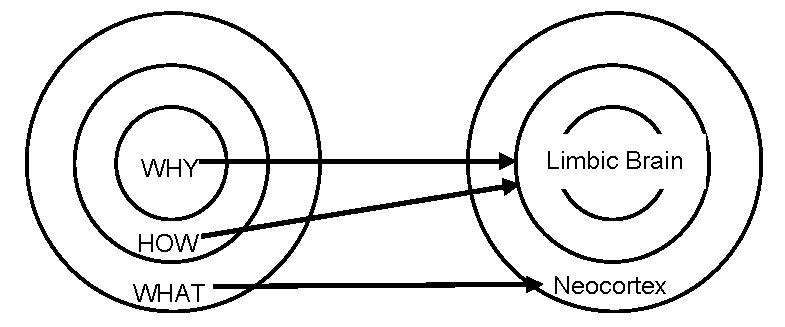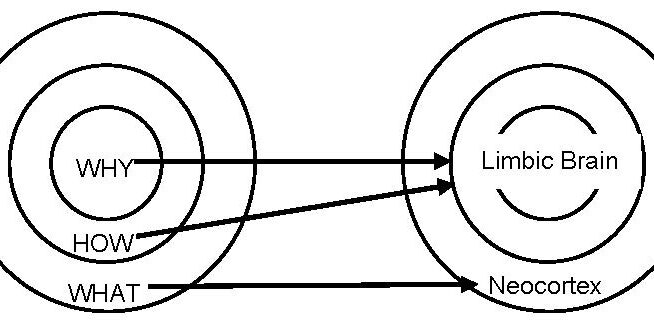Janelle M. Chiasera, PhD, ASCLS Region III Director
 |
| Figure 1: The Golden Circle and The Human Brain |
This past spring ASCLS provided a unique opportunity for members to participate in a leadership book discussion. The book selected for discussion was Start with Why: How Great Leaders Inspire Everyone to Take Action, by Simon Sinek. Participants were asked to purchase the book and to prepare for monthly discussions using Zoom. This article provides a recap of the salient points contained in the book and some additional information about how to apply Sinek’s “WHY” to discover your purpose.
As Sinek puts it, “the book is about a naturally occurring pattern, a way of thinking, acting, and communicating that gives some leaders the ability to inspire those around them.” The funny thing is … this way of thinking is the complete opposite of the way everyone else thinks. The good news is, you can learn how to do this, and that is the purpose of this book.
Sinek says that it is all about inspiring people. Inspiring leaders can create a following of people who act not because they are swayed, but because they believe in acting for the good of the whole. They act not because they have to, but because they want to. Sadly, in today’s world, inspiration is not the norm.
“[P]eople do not buy WHAT you do, they buy WHY you do it.”
How Do Leaders Inspire?
So, how can you inspire others? You need to follow what Sinek describes as the naturally occurring pattern of thinking found in all inspiring leaders—they start with WHY. Sinek calls this, “The Golden Circle” (see Figure 1). The concept of The Golden Circle was inspired by the golden ratio, a simple mathematical relationship that offers evidence of order in the seeming disorder of nature. Sinek says that The Golden Circle finds order of predictability in human behavior. In other words, it helps us understand why we do what we do.
The Golden Circle is comprised of three areas, WHY, HOW, and WHAT. The inner most circle, the WHY, is your purpose, your belief, your cause. The HOW refers to the specific actions taken by you or your organization to help realize the WHY. The WHAT portion of The Golden Circle refers to what you do, and it is often a result of your why. When most people think, act, or communicate, they tend to do so from the outside of the circle to the inside of the circle (what, how, then why). In other words, they tell you what they do, how they do it, and then try to articulate their why.
For example, if the company Apple thought from the outside in, they might sound like this:
We make great computers. (WHAT)
They’re beautifully designed, simple to use, and user-friendly. (HOW)
Do you want to buy one?
Sinek claims that this is uninspiring. Inspiring leaders and inspirational organizations think, act, and communicate from the inside out. To use the Apple example again, it would sound like this:
Everything we do, we believe in challenging the status quo. We believe in thinking differently. (WHY)
The way we challenge the status quo is by making our products beautifully designed, simple to use, and user-friendly. (HOW)
We just happen to make great computers. (WHAT)
Do you want to buy one?
It’s a completely different message. Apple is selling you on their why, their purpose, their belief, not on what they do. Sinek says that this distinction is important because people do not buy WHAT you do, they buy WHY you do it. This is what creates brand loyalty because people get inspired by your WHY.
The Biology of WHY
The interesting thing about this is that it is not opinion, it is biology. The principles of The Golden Circle are deeply grounded in the evolution of human behavior. As you see in Figure 1, the three portions of The Golden Circle correspond with the limbic brain or the neocortex. The portion of the brain known as the neocortex corresponds to the WHAT level of The Golden Circle, and is responsible for rational thought, analytical thought, and language. The middle two sections comprise the limbic brain. The limbic brain is responsible for our feelings (trust, loyalty), for our behavior, and for our decision-making. The limbic brain has no capacity for language and because of this, it makes putting our feelings into words so hard for us sometimes. This is where the term “gut decisions” comes from. Gut decisions just feel right.
There is no part of the stomach that controls decision-making—this is all happening in the limbic brain. This is why Sinek says that we need to learn how to think, act, and communicate starting from the inside of The Golden Circle—The WHY. It targets our limbic brain and that portion of our brain is powerful enough to drive behavior that sometimes contradicts our rational and analytical thought.
I challenge you to try this for yourself. Try to articulate this for ASCLS. Why does ASCLS do what we do (our cause, our belief), how does ASCLS do what it does (our actions), and what does ASCLS do? Remember, nothing worthwhile is easy.
Janelle Chiasera is dean of the School of Health Sciences and professor of biomedical sciences at Quinnipiac University in Hamden, Connecticut.
{/textblock_content}[/yee_text_block][yee_separator title=”” assign=”left” fontsize=”14″ ex_class=”” style_detail=”” yee-widget-theme=”default” border_color=”” border=”none” visiable=”1″][/yee_separator][yee_text_block css_animation=”no” ex_class=”” style_detail=”” yee-widget-theme=”default” border_color=”” border=”none” visiable=”1″]{textblock_content}
PERSPECTIVES FROM TWO START WITH WHY BOOK CLUB PARTICIPANTS
During an ASCLS constituent society leadership development workshop at the 2019 ASCLS-AGT Joint Annual Meeting, book club participants shared some of their key take-aways from the experience.
Toula Castillo, MLS(ASCP)CM, 2018-19 ASCLS-IL President
Three main items from Start with Why stood out for Toula.
1. The Concept of Engineering. In his book, Simon Sinek gives an example of two different approaches to engineering. American auto engineers fixed imperfections in car doors at the end of the assembly line by hitting the doors with a mallet. In Japan, auto makers fixed imperfections in the design room before the cars hit the assembly room floor. This anecdote made Toula think about the ways medical laboratory professionals approach problems.
“Having been in the profession and ASCLS for over 20 years,” said Toula, “I know with every fiber of my being that we know how to fix problems. It’s what we do. And we are good at it. But maybe we need to change the lens on how we fix the problem. Rather than focusing on every detail to figure out what went wrong after the fact, we instead engineer the outcome we want by asking, why are we here in the first place?”
2. Trust and Value. Sinek explains in his book that, “Trust is a feeling, not a rational experience.” It can’t be achieved with checklists or by simply fulfilling all your obligations. You also have very little time to establish trust.
“Trust begins with that first impulse,” Toula said. “If you meet someone for the first time, or the second time—and it’s been a year since you saw them at a national meeting, perhaps—maybe instead of looking at their name badges, look at their eyes, smile, and ask their name.”
As for value, Sinek believes that, “Value is the transference of trust.”
Toula said, “When we say, people don’t value what we do, what we are really saying is that we don’t feel that people trust us. But why don’t they trust us? Is it because we aren’t licensed? Is it because they don’t see us and what we do? We know what we do. And for me that’s enough.”
3. Innovation. “Real innovation changes the course of industries or even societies,” according to Sinek. However, many “innovations” can merely be shiny objects designed to attract people to try something new. A new gimmick might work, but rarely does it cement a loyal relationship.
“Rarely do people join our organization because they’ve received a free membership,” Toula said. “Kate Bernhardt, president-elect for ASCLS-IL, wrote, ‘I firmly believe that your ASCLS membership becomes more meaningful the more involved you get,’ and I couldn’t agree more.”
Jessica Lawless, MLS(ASCP)CM, ASCLS Ascending Professionals Forum Vice Chair
A self-described “hard truth kind of girl,” Jessica found one of the most interesting concepts of the book to be what Sinek calls, “the split.” A split happens to successful companies when the clarity of their WHY starts to go fuzzy. A common time for this to happen is when a longtime leader who embodies the company’s WHY leaves.
When Jessica read this, she thought, “That’s interesting. These companies had their leader for a long time. ASCLS has a very liquid leadership.” Leaders at local, state, regional, and national levels can change every year. This can affect the clarity of our message and, in turn, our ability to recruit new members and retain members in the Society.
“So, we all know why we are here,” Jessica said. “We know what we want. We know we’re passionate. But maybe that [ASCLS] WHY has gotten a little watered down, or a little fuzzy. And I’m speaking as a new person. I know that I’m passionate about this, but sometimes even as a new person it’s really hard to recruit because of that fuzziness. … It may be as simple as going back to why we’re all here and clarifying that WHY, so we can all rise with one voice.”
